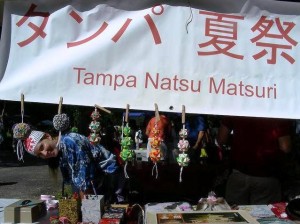Justin’s Japan: Week One of JAPAN CUTS 2012 Serves Up ‘Love Strikes!’, Adult Anime
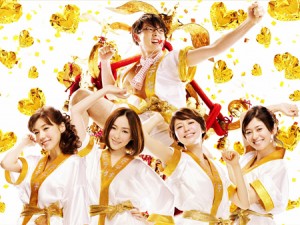
‘Love Strikes!’ has its U.S. premiere at New York’s Japan Society July 14. (© 2011 TOHO CO.,LTD. / TV TOKYO CORPORATION / DENTSU INC. / KODANSHA Ltd. / Sony Music Entertainment (Japan) Inc. / Office Crescendo Inc. / PARCO CO., LTD. / Yahoo Japan Corporation / TV OSAKA CORPORATION / TV AICHI CORPORATION)
By JQ magazine editor Justin Tedaldi (CIR Kobe-shi, 2001-02) for Examiner.com. Visit his Japanese culture page here for related stories.
From July 12-28, Japan Society ushers in its sixth consecutive year of JAPAN CUTS: The New York Festival of Contemporary Japanese Cinema. Bigger than ever, JAPAN CUTS 2012 boasts the most feature films in the festival’s history: 37 full-length and 2 shorts, encompassing blockbusters, high-concept art house titles, mature anime, audacious documentaries, delirious rom-coms and a splatter of J-horror/gore genre busters. Running alongside the New York Asian Film Festival (June 29-July 15), which co-presents 12 films from July 12-15, JAPAN CUTS 2012’s selections sport the unyielding artistry and out-of-control eccentricity that define modern Japanese cinema.
“This year’s expanded and expansive edition of JAPAN CUTS reflects our (slightly maniacal) ambition to be the ultimate platform for Japanese cinema in North America—in the world perhaps?” says Japan Society’s chief film programmer and festival curator Samuel Jamier. “In this respect, the explosive, purposefully off-balance mix of dark-themed hard-core actioners, blockbusters, hit comedies, nano-budget indie titles and philosophical art house pieces emphasizes the wild diversity of the production in the archipelago, as well as its incredible resilience, despite the rise of its East Asian neighbors and the current severe economic conditions. We might not be solving the epistemological conundrum that is Japanese and world cinema (or event zombie apocalypse), but we’re giving it a good try.”
Upcoming events include the sold out Striking Love! JAPAN CUTS Opening Party following the July 14 screening of Love Strikes!, with an introduction and Q&A with star actress Masami Nagasawa (this year’s recipient of NYAFF’s Rising Star Asia Award) and an introduction and Q&A with Monsters Club director Toshiaki Toyoda for the July 15 screening.
For this week’s list of films, click here.
JQ Magazine: JQ&A with Darryl Wharton-Rigby on ‘Don Doko Don: The Yamakiya Taiko Drum Club Project’
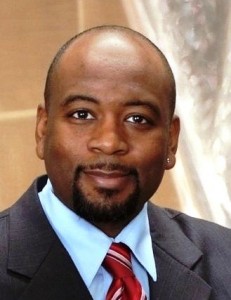
“This story is about the resiliency of community; how a community comes together in times of crisis. It’s a story about our shared human experience. It’s in some ways my own story, as my family still lives in Fukushima as well.”
By Nichole L. Knight (Shiga-ken, 2007-09) for JQ magazine. Originally from Waterbury, Connecticut, Nichole became active with the JET Alumni Association of New York even before moving to the city. Since returning from Japan, she’s played with the University of Connecticut Taiko Team, and trained with Soh Daiko, the East Coast’s oldest taiko group.
Darryl Wharton-Rigby (Fukushima-ken, 2005-07) is a playwright, poet, professor and filmmaker, who hails from Baltimore, Maryland. He has written for NBC, MTV, and BET. He lectures for Morgan State University’s Screenwriting and Animation Program, and is in the process of writing three books. Married with three children, he splits his time between Baltimore, Los Angeles, and Japan.
From 2005 to 2007, while teaching English in Kawamata-machi in Fukushima Prefecture through the JET Program, Wharton-Rigby was introduced to the talented members of the Yamakiya Taiko Club, a local community group which he would soon join. He began filming their story in 2006, but was inspired to continue after the group was misplaced in the aftermath of the 2011 tsunami and ensuing Fukushima Dai-Ichi Nuclear Power Plant area evacuations.
Of the documentary, now titled Don Doko Don: The Yamakiya Taiko Drum Club Project, Wharton-Rigby says, “…[T]his very well may be my most ambitious project. I never imagined my journey would bring me to [a] project with such an international scope and [is] profoundly personal on so many levels.” As the film’s writer, director and producer, he has unveiled an ambitious Kickstarter campaign to fund the project that closes July 11. In this exclusive interview, JQ caught up with Wharton-Rigby to discuss the origins of the film, the significance of Yamakiya on its devastated community, and the troupe’s international highlights so far.
Tell us a little about the Yamakiya Taiko Club and how you first came to know about it.
When I was a JET in Kawamata, I had to go to the Yamakiya District high in the mountains to teach at the elementary, junior high, and kindergarten schools. I met Megumi Endo, who was a school worker and head of the group at Yamakiya Elementary School. She invited me to play taiko drums with the Yamakiya Taiko Club and I was hooked. I loved the sound and power of the drums. There are three teams: Kodama, the beginning students; Suzaku, the intermediate students; and Yamazaru, the experienced members. I practiced with the younger members of Kodoma.
What inspired you to start making a documentary about them?
I started shooting footage of the group after breaking my finger. I couldn’t play the drums, but I still wanted to remain connected to the group. My background prior to JET was in film, so, I pulled out my camera and started shooting footage of the group. I would shoot rehearsals, performances, meetings, and on bus trips. I even followed around Genki Endo, who is the leader of the group. Megumi-san mentioned that it would be great to have a documentary about the group. I agreed. She came up with the title Don Doko Don—it’s the basic sound of the taiko beat. Over the years, I had compiled more than 80 hours of footage and when I would return to Japan, I would make sure to visit Yamakiya and I would bring along my camera and shoot more footage.
Why is it important to share this story with the world?
When I learned that Yamakiya was going to be evacuated because of high levels of radiation after the events of March 11, 2011, it broke my heart. I could not fathom this was really happening to a community and people I adored. Then I found out that despite the circumstances, the group was still practicing and performing together. I knew there was a story to be told. This story is about the resiliency of community; how a community comes together in times of crisis. It’s a story about our shared human experience. It’s in some ways my own story, as my family still lives in Fukushima as well.
Job: Asahi Shimbun – Full-time receptionist/assistant reporter (NYC)
Thanks to JETAA NY President Monica Yuki for forwarding on the below JET-relevant job listing. Posted by Kay Monroe (Miyazaki-shi, 1995 -97).
________________________________________________________________________________
Position: Speechwriter/Public Affairs Specialist
Posted by: The Consulate General of Japan in New York
Type: Full-time
Location: New York, NY
Salary:
Start date: N/A
Overview:
The New York Bureau of The Asahi Shimbun, a premier Japanese newspaper, seeks a full-time receptionist/assistant reporter. Main duties include office maintenance (distributing newspapers/mail to staff; answering phone calls; restocking supplies; handling correspondents’ credentials; making coffee, etc.) Secondary and occasional duties concern helping the correspondents cover a variety of news areas, particularly sports (researching; making appointments; phone-interviewing; transcribing voice files, etc.). Read More
Justin’s Japan: Interview with Jason Michael Paul on The Legend of Zelda: Symphony of the Goddesses

“My company produced and promoted the 25th Anniversary concerts. It was truly an honor to do this for Nintendo. We worked very closely with series composer Koji Kondo and his team to create the best of Zelda.” (Courtesy of Fresh PR)
By JQ magazine editor Justin Tedaldi (CIR Kobe-shi, 2001-02) for Examiner.com. Visit his Japanese culture page here for related stories.
Big in Japan for decades, symphonic concerts of that country’s most popular (and hummable) classic video game tunes have now hit critical mass in America. It’s a dream come true for fans of the blockbuster Nintendo series The Legend of Zelda, as Jason Michael Paul Productions presents the first-ever North American tour of its kind called The Legend of Zelda: Symphony of the Goddesses.
With a high profile performance in Los Angeles last month hosted by Zelda Williams (the star of last year’s Nintendo DS commercials with papa Robin, who named her after the series’ eponymous princess), Symphony of the Goddesses is playing to packed houses and has dates lined up all through November. Next up are a pair of gigs at Jones Hall for the Performing Arts in Houston July 6-7.
In this exclusive interview, I caught up with JMP CEO and the show’s executive producer Jason Michael Paul to discuss his pioneering history of bringing video game concerts to America, the special surprises planned for the tour, and his rebuttal to Roger Ebert’s notorious opinion on the artistic merit of video games.
Tell us a little about how this concert tour came to be. How did you get Nintendo’s blessing?
I have been producing VGM concerts since 2004 when I created Dear Friends: Music from FINAL FANTASY. Since then I have produced successful concerts including “PLAY! A Video Game Symphony.” Given my track record and working history with Nintendo, it was natural for my company to participate in the 25th Anniversary of The Legend of Zelda with symphony concerts in Tokyo, Los Angeles, and London. My company also produced the orchestral CD that was included in the bundle with [the 2011 Wii game] Skyward Sword. The success of the opening of the Nintendo 2011 press event, the 25th Anniversary Concerts, and the recording paved the way for the license to produce The Legend of Zelda: Symphony of the Goddesses.
How did The Legend of Zelda game series first appear on your radar?
In 1987, when my parents purchased it for me to play on my NES.
What’s your favorite Zelda game and why? How would you define the series’ appeal?
My favorite Zelda game is the latest release because I feel as if I contributed to the tile. I was honored to produce the orchestral CD that accompanied the release of the game. The series has appeal through excellent gameplay and music. Throughout its 25-year history Zelda has consistently featured a solid mixture of action, puzzles, battle, adventure gameplay, exploration, and questing.
For the complete story, click here.
JQ Magazine: In Texas, Metroplex Lolitas Paint the Town
By Jen Wang (Miyagi-ken, 2008-09) for JQ magazine. Jen is a research technician from Dallas who also writes for Purple SKY, a Japanese music website. Her love of cosplay and her junior high school students inspired the name for her own Japanese pop culture blog, Hibari-sensei’s Classroom.
The Japanese fashion subculture Lolita is based on Victorian and Rococo aesthetics. Its trademark look consists of a blouse, a knee-length skirt or jumper, a petticoat, stockings, and Mary Janes or platform shoes. Since its inception in the 1970s, Lolita has developed several sub-styles: gothic, sweet, classic, punk and more. There is also a mature variation known as aristocrat and a masculine equivalent known as ouji.
Although I had been interested in Lolita since college, I didn’t really start compiling a Lolita wardrobe until I was a JET. It was easier to figure out what styles worked when you could try on the clothes. I visited the seventh floor of Sendai Forus—the location of punk, gothic and Lolita stores—so frequently that the shopkeepers started to recognize me. The budding fashionista in me missed the shopping trips and opportunities to dress up once I returned to the U.S. Then I discovered the Metroplex Lolita LiveJournal group.
The Metroplex Lolitas are a group of from the Dallas-Fort Worth area. Prior to their creation in January 2010, several of the girls had been arranging meet-ups through another group, Texas Lolis. They decided to branch off to encourage more conversation and gatherings.
My first meet-up was in March 2010. We went to watch Tim Burton’s Alice in Wonderland and sat down for tea and a gift-exchange afterwards. The Metroplex Lolitas meet around once a month to enjoy a meal—true to our Victorian influences, we do love tea and pastries—or an activity, which can be anything from a trip to the museum to ice skating. The Texas heat has never deterred us from getting together in our layers of frills since many members have come up with more summer-friendly outfits. We also host meet-ups with out-of-town Lolitas at anime conventions.
JQ Magazine Seeks Writers for Summer 2012!
As we slide into summer, JETAA New York’s JQ magazine continues to provide content with an ever-expanding array of articles, interviews and features (see our recent stories here). We’re now looking for new writers, including recent returnees and JET vets, from all JETAA chapters worldwide for posting stories via our host at the global JET alumni resource site JETwit.com. (Scribes are also encouraged to join the JET Alumni Writers group on LinkedIn.)
Below are story ideas grouped by JET participants and alumni (JET World) and those more on Japanese culture (Japan World). And if you’re a JET or JETWit contributor from anywhere in the world with a story idea of your own, let us know!
Click “Read More” below for our summer 2012 ideas pitch package, and contact JQ editor Justin Tedaldi (magazine [at] jetaany [dot] org) to sign up for stories.
JQ Magazine: JQ&A with Mark Flanigan, Program Director of the Japan ICU Foundation
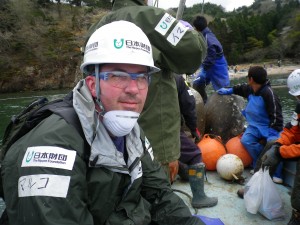
Mark Flanigan volunteering with local fisherman for tsunami relief during Golden Week in Oshika Hanto, Ishinomaki, 2011.
By Shirley Dang (Yamanashi-ken, 2009-10) for JQ magazine. Shirley enjoys sipping chai latte and devouring scrumptious cakes while continuing her pursuit for Japanese- and education-related jobs. Visit her Facebook page here.
Mark Flanigan (Nagasaki-ken, 2000-04) currently lives on the campus of International Christian University (ICU) / 国際基督教大学 in Tokyo, where he is finishing up his two-year M.A. in peace studies as a Rotary International Peace Fellow. Last year he volunteered at Ishinomaki post-3/11, playing a vital role in tsunami relief. Following graduation, Mark will move to New York City in July to work as a new program director with the Japan ICU Foundation (JICUF). JQ recently caught up with him to learn more about his extraordinary experiences.
Hi, Mark, welcome to the Big Apple! What’s your background story and how did it influence you to be a JET?
Thank you, Shirley! I’m glad to have the chance to introduce myself here. Well, I actually came into JET through my interest in teaching, rather than a specific focus on Japan. I wasn’t an Asian studies major in college, and I had never traveled anywhere except Europe and the Americas at that point. My first direct experience with Teaching English as a Foreign Language (TEFL) was spending about a year in Morelia, Mexico, which I really loved. After I returned to the U.S., I taught English at an international school for a while, but I wanted to experience the feeling of living in a different culture again. That led me to apply to JET, and I was lucky to have some great advice and support from both Japanese people and JET alumni living in D.C. I still remember how happy I felt when I received the acceptance letter in the mail!
What was your time on JET like, and how did it play a role in your future career plans?
My original plan, like many JETs, was to stay just one year. I had applied to grad school and thought I would finish up with my original contract. Needless to say, I became quite fascinated with the people and culture I found as a municipal ALT in Hirado, Nagasaki Prefecture, and decided to re-contract. I was then offered a promotion of sorts, and became the Teacher-Trainer ALT at the Prefectural Education Center, which was a great experience. In my last year, I also served in tandem with my other duties as the Nagasaki Prefectural ALT Advisor. In all, I ended up staying in Nagasaki for a total of four years! After that, I returned to D.C. and attended grad school in Public Policy at George Mason University. I was selected as a Presidential Management Fellow and worked for the U.S. government until 2010.
I see that you were a Rotary Peace Fellow at the ICU in Tokyo—how did that happen? And as a fellow, what were your roles and responsibilities? Anything you want to share?
I was very fortunate to have met Daniel Sturgeon (Gifu-ken, 2000-02), a JET alumnus and former Rotary Peace Fellow, in Washington. He and I shared many similar interests regarding public service and international exchange, and he strongly encouraged me to pursue the Rotary Peace Fellowship. As ICU in Tokyo is one of the partner universities with Rotary for administering the Peace Fellowship, it was a perfect way for me to return once more to Japan.
Daniel was absolutely instrumental in helping me prepare for the application and selection process, which is certainly rigorous, but very much worth the time and effort. In two years, I was able to graduate with a fully-funded M.A. in Peace Studies, with direct experience interning at the United Nations in Geneva in summer 2011, thanks to the generosity of Rotarians worldwide who enable this outstanding Peace Fellowship program to develop.
I would certainly encourage any former JETs who are interested to review the current application at www.rotary.org/rotarycenters. Being a JET means you have already experienced Japanese culture directly, which is a huge plus with Rotary! You can also find a local Rotary Club for endorsement at www.rotary.org/clublocator. The annual application deadline is coming up, so if you are interested, apply ASAP!
JQ Magazine: Book Review – ‘Shiro’ and ‘Otaku Spaces’

“‘Shiro: Wit, Wisdom and Recipes from a Sushi Pioneer’ and ‘Otaku Spaces’ are enjoyable reads for raw fish enthusiasts and confessed Japanophiles of all ages!” (Chin Music Press)
By Preston Hatfield (Yamanashi-ken, 2009-10) for JQ magazine. Preston moved from San Francisco to New York City in January 2012 and is now accepting submissions from people who want to be his friend. Abduct him from his house in the middle of the night, or find him on Facebook and ask about his JET blog in which he details his exploits and misadventures in that crazy Land of the Rising Sun we all love.
This month, JQ takes a moment to showcase two ambitious literary works and the indie press that brought them to print. As a writer with experience in book publishing evaluating and responding to a variety of unsolicited book proposals (we refer to this as the business of crushing dreams), I have been given the privilege of reviewing these works. Therefore, in consideration for readers who won’t read beyond this paragraph, I’ll begin with a sound bite endorsement: “Shiro: Wit, Wisdom and Recipes from a Sushi Pioneer and Otaku Spaces (published by Chin Music Press in 2011 and 2012, respectively) are enjoyable reads for raw fish enthusiasts and confessed Japanophiles of all ages!” —Preston Hatfield
Shiro is the autobiographical account of Shiro Kashiba, the “Godfather of Seattle Sushi” who first introduced the cuisine to the Emerald City in 1966. His story is one of passion, that inspirational drive that likens a man to a salmon swimming upstream—tireless, blind to distraction, and staunchly determined to reach his destination. It guides him, from his childhood home in Kyoto to his first apprenticeship in a sushi restaurant in Ginza, and eventually, to Seattle, where he now continues to perform and perfect his trade in his own restaurant.
His passion transcends mere desire to practice the honored tradition of Edomae sushi—a tradition whose authenticity he strives to preserve despite America’s penchant for fusion rolls and sauces than are anything but canon—and, indeed, finds its footing in the very earth that lavishes the bounty of ingredients he handpicks to make his exquisite, culinary triumphs. An avid hiker and environmentalist, Shiro is perhaps concerned less about the food than he is in urging people to treasure and protect our natural resources, particularly Puget Sound in the Pacific Northwest.
While the narrative and style do not always do Shiro’s experiences justice (he is a renowned chef, after all, and not a writer), they do give a concise and linear account of Shiro’s life, and an overview of the challenges he faced every step of the way. With simple language, a humble tone, and a professional’s knowledge and insight, Shiro holds his reader’s attention throughout the book, leading them at a surprisingly brisk pace. This pace, while gratifying in its ability to usher us through Shiro’s Greatest Hits, does not allow for very as many sensory details and anecdotal detours as some readers might prefer.
JETAA Southern Alberta Newsletter – Spring 2012
 Thanks to JETAA Southern Alberta Media Coordinator John Nguyen (Hokkaido, 2008-10) for sharing the Spring 2012 issue of “Express Shinkansen,” the very excellent JETAA Southern Alberta Newsletter:
Thanks to JETAA Southern Alberta Media Coordinator John Nguyen (Hokkaido, 2008-10) for sharing the Spring 2012 issue of “Express Shinkansen,” the very excellent JETAA Southern Alberta Newsletter:
- Spring 2012 JETAA Southern Alberta Newsletter (PDF): http://jetaasa.ca/newsletter/Shinkansen_Express_v4.1.pdf
- You can find links to all current and past issues of JETAA Southern Alberta’s “Express Shinkansen” at: http://www.jetaasa.ca/media/newsletter/
Justin’s Japan: Interview with Sake Evangelist/JET Alum John Gauntner
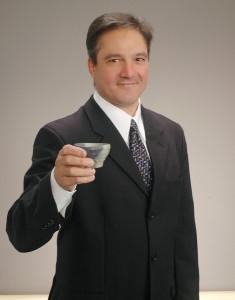
“It was not one big thing but rather a million coincidences that led me to apply for the JET Program. I never, ever imagined I would stay here very long, much less 24 years (and counting)!” (Courtesy of John Gauntner)
By JQ magazine editor Justin Tedaldi (CIR Kobe-shi, 2001-02) for Examiner.com. Visit his Japanese culture page here for related stories.
Known as the Sake Guy or the Sake Evangelist, John Gauntner (Kanagawa-ken, 1988-89) is the world’s leading non-Japanese authority on the nation’s signature beverage, penning numerous books on the subject and touring the world with his popular seminars and speaking engagements.
An Ohio native who currently resides in Kamakura, Gauntner returns to America next week to anchor Rice & Water: The Building Blocks of Premium Sake, this year’s annual sake lecture and tasting at New York’s Japan Society on June 19. The Evangelist will introduce the importance of rice and water in sake brewing, and a special sake tasting reception with more than 30 kinds of premium sake will follow.
It actually was the result of countless coincidences. I did not plan it, really. I just got interested in sake, and after drinking with a friend that worked at the The Japan Times, he asked me to write a piece for them. That led to a column, which led to a book, which led to another. I got involved in the industry so I could study more and that led to my involvement in export and education. I didn’t really choose this path; it chose me.
What attracted you to Japan originally, and how did you get the opportunity to first go there?
Again, I have to say that it was not one big thing but rather a million coincidences that led me to apply for the JET Program. I never, ever imagined I would stay here very long, much less 24 years (and counting)!
As a participant in the early days of the JET Program, what things about Japan and its people do you feel have changed for the better since then?
I was in Kanagawa and participated in JET for two years, ’88 and ’89. But I have been here the whole time, and the changes have taken place so gradually it is hard for me to see them. Certainly, though, a familiarity with people from other countries has changed—for the better!
For the complete story, click here.
Justin’s Japan: Hideo Kojima and Yoji Shinkawa Salute 25 Years of Metal Gear at Uniqlo NYC
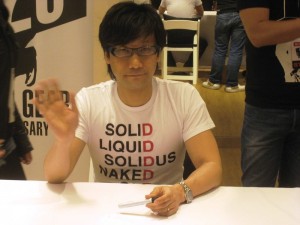
Hideo Kojima, director of the Metal Gear video game series, at Uniqlo 34th Street store in Manhattan, June 9, 2012. (Justin Tedaldi)
By JQ magazine editor Justin Tedaldi (CIR Kobe-shi, 2001-02) for Examiner.com. Visit his Japanese culture page here for related stories.
Japanese retail clothing giant Uniqlo is commemorating a quarter century of Metal Gear—the classic Konami stealth video game series—with a new line of 10 exclusive UT Metal Gear 25th Anniversary T-shirts. On June 8 and 9, series director and game designer Hideo Kojima and artist Yoji Shinkawa made a special appearance at two off Uniqlo’s New York stores with for a special autograph session to commemorate a quarter century of Solid Snake, Big Boss and the eponymous bipedal tank that started it all.
“There were over 2,000 people who attended the UNIQLO Metal Gear event at both Fifth Avenue and 34th Street,” according to Mary Lawton, a spokesperson for Uniqlo. “This is our second event with Metal Gear and we are always thrilled at the level of support we receive from the Konami team as well as the loyal fans of Metal Gear.”
Kojima has made previous appearances at Uniqlo New York’s Soho flagship store in 2008 and 2010.
Fans attending the event who made a $30 store purchase were allowed to have one game-related item signed by Kojima and Shinkawa. Most of the items were related to the Metal Gear Solid series, which began in 1998 on the Sony PlayStation console. (The original Metal Gear was released in the U.S. a decade earlier for the Nintendo Entertainment System.) Most of the fans in attendance were American, attributing to the international influence and success of the Japanese-created game series.
For the complete story, click here.
JQ Magazine: App Review – Japanese Flash and Rikai Browser
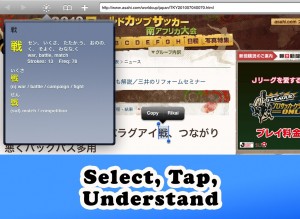
"The best study materials are ones that are easy to pick up and make a habit of using. It’s also important that they’re easy to use after being neglected for a while. Both Japanese Flash and Rikai Browser pass that test." (Courtesy of Long Weekend LLC)
By Jarrad Skinner (Toyama-ken, 2007-2011) for JQ magazine. Jarrad is a game design student. He’s rediscovering New York by going to lectures, comedy shows, meetups, concerts, bars, restaurants, and by skipping subway rides for long walks whenever possible. You can find him sleeping on the LIRR.
It’s June. That means six months until the Japanese-Language Proficiency Test in December, so it’s a good time to take a look at goals and study materials and get crackin’. Long Weekend LLC has two iOS apps, Japanese Flash and the Rikai Browser, which may help.
JET alum Mark Makdad (Toyama-ken, 2005-06), Long Weekend’s director and co-founder, explains what sets their apps apart: “We took the dictionary approach but added on two important things: an SRS algorithm to show you words you’d already looked up and saved to a custom set, and 150+ sets of useful and/or interesting words pre-loaded so people can just study vocabulary relevant to their situation,” he says. “For example, there’s a ‘Drinking Words’ set–if you’re going out to an izakaya with Japanese friends for the first time, you’ll probably want to learn a few ahead of time!”
Learning Japanese has become much easier in the past five years. When I started JET in 2007 and began studying Japanese, I used a ragtag paper pocket dictionary that my predecessor had left on my desk. It got me through a lot but not without a lot of tedious fumbling, and I was envious of my fellow JETs with their fancy electronic dictionaries. Those fancy electronic dictionaries are really expensive, though. It wasn’t until the middle of my third year on JET that I upgraded from my not-so-sturdy pocket dictionary. I had gotten an iPhone and immediately put the free dictionary Kotoba! on it. This was not a minor thing, but a cause of a marked improvement in my quality of life as a JET.
Not only was I more willing to jump into Japanese conversations because I knew I could quickly look up a key word if I needed to, but students and teachers were more willing to try to talk with me and have deeper conversations because they knew the dictionary app was right there to help them, too. Never having to learn how to look up kanji by stroke order in a paper dictionary was also appreciated.
Justin’s Japan: New York Mets Present Third Annual Japanese Heritage Night
By JQ magazine editor Justin Tedaldi (CIR Kobe-shi, 2001-02) for Examiner.com. Visit his Japanese culture page here for related stories.
After two successful runs, the New York Mets are prepping the third annual edition of its Japanese Heritage Night at Citi Field, featuring pre-game entertainment that celebrates both the traditional performing arts and the enduring spirit of the Land of the Rising Sun a year after the devastation of the Great East Japan Earthquake.
The festivities kick off the evening of Friday, June 15 when the Mets play the Cincinnati Reds. Appearing in the pre-game show this year are the New York Suwa Taiko Association (also known as Taiko Masala) and the Japanese Folk Dance Institute of New York. Following the entertainment, patrons will be treated to the presentation of Mets Community Spirit Awards to New York City Japanese organizations that have been instrumental to the ongoing relief efforts.
The only taiko group based in Brooklyn, Taiko Masala was founded by Hiro Kurashima. A Lincoln Center Teaching Artist from 2004 to 2005, Kurashima has sought to bring the influences of various types of music into the art of Japanese music while at the same time preserving the rich tradition of taiko. The 10-member troupe, whose drummers hail from all over the world, have played such high profile New York events like last year’s Japan Arts Matsuri, and will make their Citi Field debut on game day.
For the complete story, click here.
This year, The JET Alumni Association of New York will be purchasing a block of tickets in the Promenade Reserved area for $20 each. If they buy 25 tickets, their name will be displayed on the scoreboard! Sign up here to reserve your tickets.
By John McGee (Nagano-ken, 2004-05) for JQ magazine. John is the Tampa Regional Representative for the Florida JET Alumni Association, and the founder of Tampa Natsu Matsuri, a free annual event organized by local residents with an interest in Japan.
It’s a familiar story: apply to JET for one of several reasons, go to Japan and find a second home, return to the U.S., and…well, that’s where it all falls apart, right? Most of us come back intent to keep our newfound hybrid culture alive, but few areas in the U.S. have profound Japanese cultural presence. So we sigh with natsukashii pangs when we can’t take our beer out of the bar, we hang out with JETs on occasion, download the odd drama, and let the rest of our lives go back to American normal, like it or not.
That was certainly the case for me here in Tampa. There’s a bit of Asian presence: restaurants, markets, a festival, even a karaoke place, mostly all Korean or Chinese. But I’ve never been content with the status quo. (I know; how did I survive in we-do-it-this-way-because-that’s-how-it’s-done Japan, right?) So I started probing some contacts at the university, searching the Internet for related local topics; I even knew some Japanese nationals living here.
I discovered that the area actually has quite a bit of Japanese culture…it’s just hiding. Turns out the people are hiding, too. There’s a whole thriving subculture in the region made up mostly of Japanese women who have married American men. But there’s also martial and cultural arts, anime clubs, language groups, and we even have a pack of strangely elusive diehard Loli girls. The problem wasn’t that we didn’t have the culture; it was that it was so diffuse and cloistered.
About the time I was figuring all this out, a JET friend suggested we have a natsu matsuri party, just to reminisce and eat some suika in the sweltering Florida heat. That’s when a light bulb came on and I realized, “what better way to draw those groups together than to have a real natsu matsuri?” Everyone I ever met who lived in Japan, Japanese and foreign, loved natsu matsuri. So it just might work! If nothing else, I missed them myself.

"Every chance I get, I would like to perform. I feel that in order to keep this genre of music alive, the younger generation of Japan needs to be exposed to it more often. I am happy that I am able to keep my current younger fans and gain new ones." (Guan Barl)
By JQ magazine editor Justin Tedaldi (CIR Kobe-shi, 2001-02) for Examiner.com. Visit his Japanese culture page here for related stories.
Since becoming a star in Japan in 2008 for his interpretations of enka, or Japanese ballads, singer Jero is now poised to make his New York debut at Japan Society on June 9 withLet’s Enka! with Jero, where he will perform a selection of karaoke-accompanied enka classics and talk about his childhood, his trailblazing success, the challenges he’s faced and his love for the uniquely Japanese genre of music.
Born Jerome Charles White, Jr., the 30-year-old Pittsburgh native was born of mixed Japanese and African American heritage. He was exposed to enka and the Japanese language as a child by his grandmother, a native of Yokohama. Jero’s first single released in Japan, “Umiyuki” (“Ocean Snow”), entered the top five of the national pop charts, which helped the fledgling vocalist win Best New Artist of 2008 at The 50th Annual Japan Record Awards.
Following his Japan Society debut concert, Jero will participate in a rare meet-and-greet with fans, selling and signing his CDs as well as special Jero tote bags, the proceeds of which will be donated to JERF, the Japan Earthquake Relief Fund, set up by Japan Society in the wake of 3/11. In this exclusive interview, I caught up with Jero on his difficult pre-stardom days in Japan, the turning point that encouraged him to perform in America, and his role as a global envoy of enka.
Your New York debut will be held at Japan Society. How did this come together?
I received an e-mail for the event asking me to perform. I forwarded the e-mail to my manager and there you have it!
Tell us a little about your previous live performances in North America. What were your expectations and how were the shows received?
My very first performance in the U.S. [in 2008] was at my alma mater, the University of Pittsburgh. Two years later, I was given the opportunity to perform in L.A. and San Francisco. I actually was against performing in the U.S. because I wasn’t sure how it would be perceived by the U.S. audience, as all the songs are in Japanese. I received a lot of positive feedback after those performances, which gave me a confidence I never had before.
You’ve said before that you would like to keep performing on the Japanese New Year’s Eve music program Kohaku Uta Gassen every year and continue to get younger audiences listening to enka. How do you feel this has been going so far, and how do you feel about introducing enka to a younger generation of fans?
Every chance I get, I would like to perform. Because the enka audience has decreased every year, outlets to perform have also decreased. I feel that in order to keep this genre of music alive, the younger generation of Japan needs to be exposed to it more often. I am happy that I am able to keep my current younger fans and gain new ones.
For the complete story, click here.
Read an exclusive interview with Jero from the winter 2009 issue of JQ magazine here.



